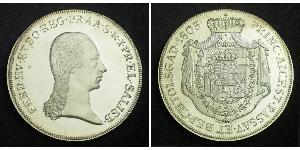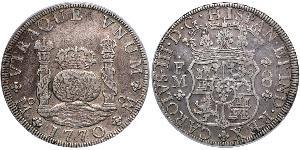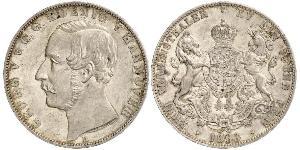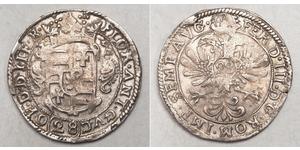(sold for $338.0)
1787, Landgraviate of Hesse-Cassel, William IX. Large Silver Thaler Coin. XF!
Mint Years: 1787 Reference: Davenport 2305, KM-532. Denomination: Mining Thaler - struck from silver ore gathered at the Bieberer mountain silver mines Condition: Weight-adjusting marks in obverse, minor deposits and light scratches, otherwise XF! Weight: 27.87gm Diameter: 40mm Material: Silver
Obverse: Bust of William I (as William IX Landgrave) right. Mint official´s initial (H for Carl Ludwig Holzemer, die cutter) insider bust truncation. Legend: WILHELMUS IX . D : G : HASS : ANDG : CUM : HAN .
Reverse: Crowned oval coat-of-arms withon Order of the Garter, supported by two crowned roaring lions. Four orders hanging below. Date (1787) and mint official´s initials (F-H) in fields below, fractional silver mark value above. Order of the Garter Inscription: HONI . SOIT . QUI . MAL . Y . PENSE . . . (""Shame be to him who thinks evil of it!") Legend: X. EINE FEINE MARCK / BIBERNER SILBER . / F-H, 17-87
This statement "Honi soit qui mal y pense" supposedly originated when King Edward III was dancing with his first cousin and daughter-in-law, Joan of Kent. Her garter slipped down to her ankle, causing those around her to snicker at her humiliation. In an act of chivalry Edward placed the garter around his own leg, saying "Honi soit qui mal y pense", and the phrase later became the motto of the Order.
The Landgraviate of Hesse-Kassel (German: Landgrafschaft Hessen-Kassel), known as Hesse-Cassel during its existence, was a state in the Holy Roman Empire under Imperial immediacy that came into existence when the Landgraviate of Hesse was divided in 1567 upon the death of Philip I, Landgrave of Hesse. His eldest son William IV inherited the northern half and the capital of Kassel. The other sons received the Landgraviate of Hesse-Marburg, the Landgraviate of Hesse-Rheinfels and the Landgraviate of Hesse-Darmstadt. The Landgrave of Hesse-Kassel was elevated to the Electorate of Hesse and Landgrave William IX was elevated to Imperial Elector during the reorganization of the Empire in 1803, in the midst of the Napoleonic wars, and later occupied by French troops and became part of the Kingdom of Westphalia, which was a French satellite state.
William I, Elector of Hesse (German: Wilhelm I., Kurfürst von Hessen; 3 June 1743 – 27 February 1821) was the eldest surviving son of Frederick II, Landgrave of Hesse-Kassel (or Hesse-Cassel) and Princess Mary of Great Britain, the daughter of George II.
William was born in Kassel, Hesse in 1743. His father, landgrave Frederick II (who died in 1785), had in 1747 abandoned the family and reverted to Catholicism. In 1755 he formally annulled his marriage. William's grandfather, Landgrave William, granted the newly acquired principality of Hanau to his daughter-in-law and grandsons. Technically, young William became the reigning prince of Hanau, while under his mother's regency. The young prince William, together with his two younger brothers, lived with their mother, the landgravine Mary. From 1747 they were supported by Protestant relatives and moved to Denmark. There they lived with Mary's sister, Louise of Great Britain, and her family; Louise died in 1751.
On 1 September 1764, William married his first cousin, Wilhelmina Caroline of Denmark and Norway (1747–1820), who was the second surviving daughter of Frederick V of Denmark and Norway. They married at Christiansborg Palace and resided for two decades mostly in Denmark.
In 1785 they moved to Kassel when William succeeded to the landgraviate. During the lifetime of his father, William had already received the Principality of Hanau, south of the Hessian territories near Frankfurt, as successor of its newly extinct princes. The Hanau people did not want to have a Catholic ruler.
William's younger brother Charles in 1766 married another of their Danish first cousins, Princess Louise of Denmark.
Upon the death of his father on 31 October 1785, he became William IX, Landgrave of Hesse-Kassel. He was said to have inherited one of the largest fortunes in Europe at the time.[citation needed]
William looked for help in managing his estate. He hired Mayer Amschel Rothschild as "Hoffaktor" in 1769, to supervise the operation of his properties and tax-gathering. The wealth of William's estate provided a good living for Rothschild and the men had a strong relationship; he founded the Rothschild family dynasty, which became important in financing and banking in Europe. Although they had been acquainted since 1775, William IX did not formally designate Rothschild as his overseer until 1801.
The early fortunes of the Rothschild family were made through a conjunction of financial intelligence and the wealth of Prince William. During the Napoleonic Wars, William used the Frankfurt Rothschilds to hide his fortune from Napoleon. This money then saw its way through to Nathan Mayer, (N.M.) in London, where it helped fund the British movements through Portugal and Spain. The interest made from this venture was reaped by the budding banker barons, who used it to swiftly develop their fortune and prestige in Europe and Britain. It was not long before their riches outweighed those of their benefactor, William of Hesse-Kassel.
In 1803, Landgrave William was created His Royal and Serene Highness The Prince-Elector of Hesse. In 1806 his electorate was annexed by the Kingdom of Westphalia, ruled by Jérôme Bonaparte, Napoleon's brother. William escaped to Denmark with his family and lived there in exile until the French were expelled from Germany. Following the defeat of the Napoleonic armies in the Battle of Leipzig, William was restored in 1813.
He was a member of the Tugendbund, a quasi-Masonic secret society founded after the Battle of Jena–Auerstedt in June 1808 at Koningsberg.
Several other prince-electors of the Holy Roman Empire had been recognized as kings at the Congress of Vienna (1815), and William attempted to join them by declaring himself King of the Chatti. However, the European powers refused to recognize this title at the Congress of Aix-la-Chapelle (1818) and instead granted him the grand ducal style of "Royal Highness." Deeming the title of Prince-Elector to be superior in dignity to that of Grand Duke, William chose to remain an Elector, even though there was no longer a Holy Roman Emperor to elect. Hesse-Kassel would remain an Electorate until it was annexed by Prussia in 1866.
He ruled until his death in Kassel in 1821. He was succeeded by his son William.
Only 1$ shipping for each additional item purchased!

|
Posted by:
anonymous 2017-08-01 |
3 Mark Kingdom of Bavaria (1806 - 1918) Silver Otto of Bavar ...
group has 79 coins / 74 prices
⇑
28 Stuber Silver
group has 9 coins / 9 prices
⇑















-300-150-rXQKbzbio4IAAAFRuo9au1dV.jpg)








